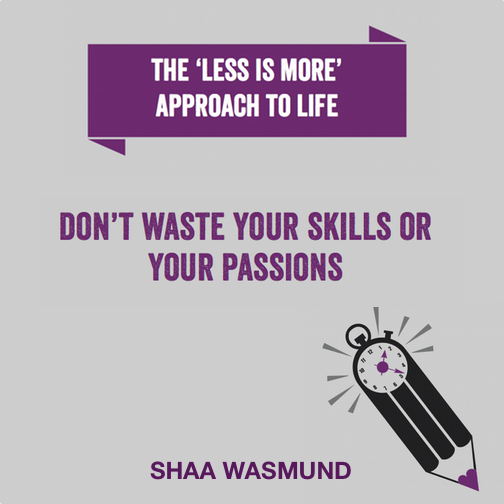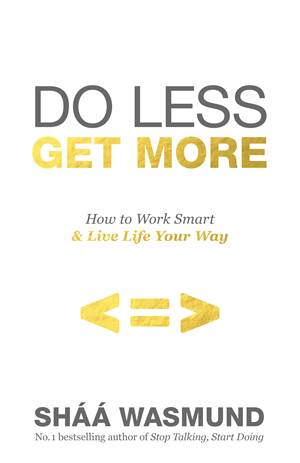I’m delighted to announce the first in a new series – reviews of World-Changing Books, books with a strong idea and a big impact, books that aspiring World-Changing Writers can learn from.
I’ll tell you about the message of the book, but I’ll also look under the hood as a publisher and pull out the lessons – editorial, production, design, even marketing – that make them so interesting for other writers.
Where possible I’ll also bring you insights from the author themselves: I met Sháá at a bootcamp event last month and she kindly agreed to answer the questions below.
World-Changing Books: Do Less Get More by Sháá Wasmund (2015, Penguin Random House)
Who’s it by?
Sháá Wasmund, MBE is one of the UK’s most prominent female entrepreneurs. She’s worked with the likes of Chris Eubank, James Dyson and Bob Geldof, before setting up the small-business support network Smarta in 2009. Her first book, Stop Talking, Start Doing (2012) was #1 in the bestseller charts for an incredible 14 months.
Who’s it for?
Anyone who feels they’re busy but not as happy or productive as they’d like, although it will have particular resonance for business owners and entrepreneurs.
What’s the key message?
‘Do what you love and let go of the rest’ – find the things and people you really care about, focus on what’s important, and delegate or ditch the stuff that takes your time and energy away from them.
How does it change the world?
It’s a brilliant distillation of Sháá’s trademark motivational genius, her own experience as a busy mum and the best productivity thinking. It provides not only the motivation but the practical tools for anyone to make their life more fulfilling. Sháá’s personality comes through strongly: the tone is direct and engaging, if you’ve seen her speak on stage it’s very easy to imagine her speaking out loud to you through the pages.
What’s interesting about it from a writer’s perspective?
· Sháá admits that she (like me) is a post-it junkie – every project, including this book, is first brainstormed with a flurry of post-its which can then be reorganized. She also uses mindmaps to structure her thinking, and interestingly includes a mindmap of the book itself showing the four parts and their constituent chapters. Her organized thinking really comes through in the book; every paragraph has a distinct idea and each chapter follows on smoothly from the one before.
 · The design is bold and distinctive, which suite the tone of the writing perfectly. The book is printed in two inks (not only black but purple too, which is Sháá’s brand colour): this gives the designer seven shades to play with – white, black, mid-grey, light-gre, solid purple, mid-tint purple and light-tint purple – and all seven are used to great effect in the diagrams, cartoons and infographics. Two-colour printing is not usually available print on demand, and is more expensive than black and white so even traditional publishers will usually avoid it unless there’s a good business case for something really distinctive, but it’s a good reminder that even black and white can give several possibilities for tints that can lift a design out of the ordinary.
· The design is bold and distinctive, which suite the tone of the writing perfectly. The book is printed in two inks (not only black but purple too, which is Sháá’s brand colour): this gives the designer seven shades to play with – white, black, mid-grey, light-gre, solid purple, mid-tint purple and light-tint purple – and all seven are used to great effect in the diagrams, cartoons and infographics. Two-colour printing is not usually available print on demand, and is more expensive than black and white so even traditional publishers will usually avoid it unless there’s a good business case for something really distinctive, but it’s a good reminder that even black and white can give several possibilities for tints that can lift a design out of the ordinary.
· There’s effective use of the PAS model – problem, agitate, solution – as Sháá asks ‘When did life get so complicated?’ and agitates it by drawing out the problems most of us are familiar with (stress, guilt, lack of productivity, strained relationships, procrastination etc), and the rest of the book focuses –thankfully! – on the solutions.
· Subtle but effective links to Sháá’s website. For example there’s an abbreviated ‘strengths exercise’ on p.94 which works well on its own terms but links to the fuller interactive tool on her site. But the focus is not on driving traffic, it’s on building awareness and trust, and there’s no hint of salesmanship, the ‘call to action’ is simply the central message of the book: simplify, prioritise, focus.
· Effective use of quotations. The book is scattered with short, well-chosen quotations from old and new thinkers. They are often designed up (eg enclosed in stylized quotation marks), they top and/or tail sections, and more importantly they support and reinforce Sháá’s messages, a form of in-book social proof.
· This is squarely a trade book: there’s no scholarly apparatus such as citations, footnotes or bibliography, but there’s a practically focused ‘Resources and sources’ section at the end that lists useful productivity apps and a reading list of ‘inspiring words’ which includes books, journal, newspaper and magazine articles, TED talks and websites.
 More from Sháá herself…
More from Sháá herself…
You say in Do Less Get More that you’d wanted to write a book since you were a teenager, and you invested in a premium workshop with Tim Ferriss to kickstart it. What was so important to you about becoming an author? Has it been what you expected?
I realised very early on that writing books would allow me to reach as many people as possible. If you fieel that you have a really powerful message, then books in my opinion are one of the best mediums for reaching your tribe.
How did you plan out this book? Did you find yourself revising the structure as you went or did you only start writing when you had the structure clear?
I revised as I went and when I was 70% of my way through, I threw everything away and started again.
The diagrams in the book are very distinctive, as is the use of purple – how much input did you have into the design, and how closely did you work with the illustrator?
Incredibly closely. It was part of my “must haves” when signing a deal with a new publisher.
Has writing the book changed you? If so, in what ways?
It’s allowed me to fulfil a lifelong ambition and has undoubtedly changed my career path.

